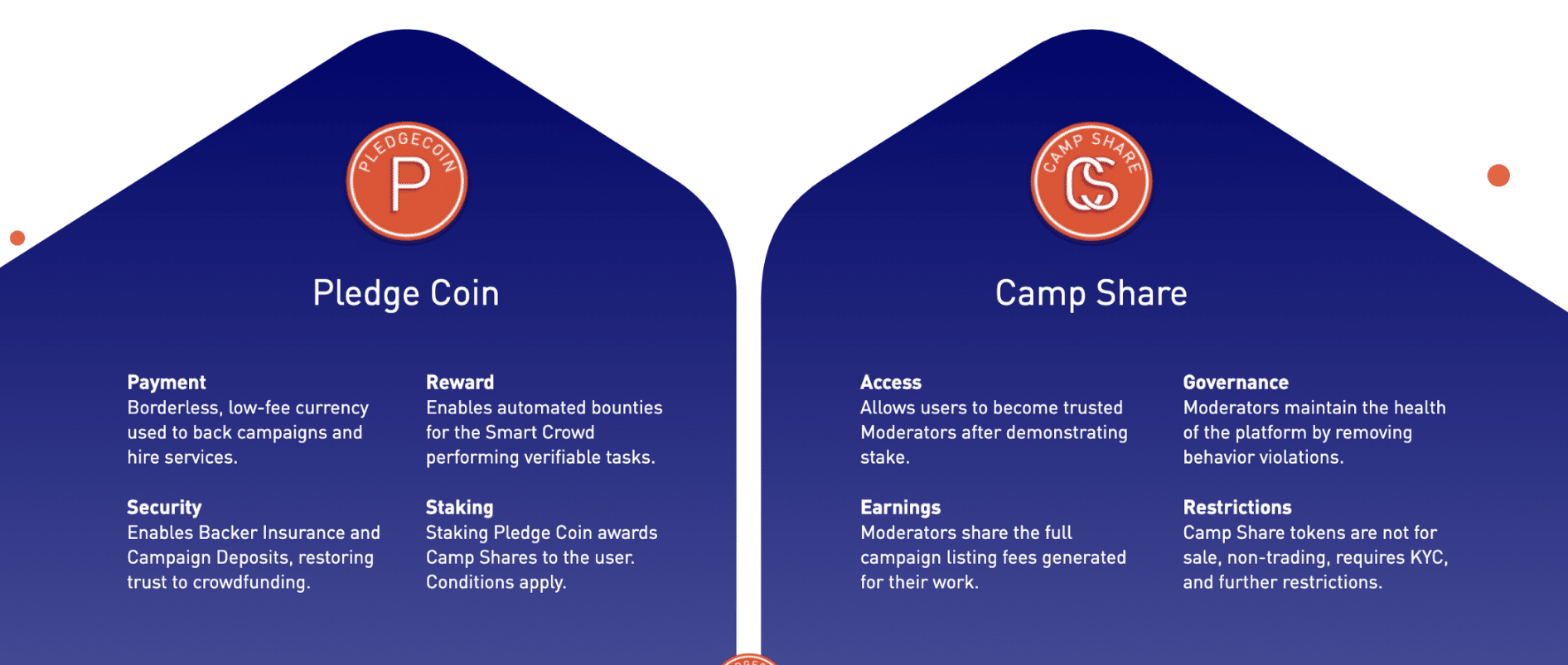These days, getting any project off the ground is a challenge.
This is becoming increasingly true in the Blockchain world. The days of ‘wild-west’ ICOs are over; investors are no longer just throwing money at any project that has smeared the word ‘decentralized’ all over itself.
Indeed, the vast majority of token sale-backed projects started over the last two years are either dying a slow death or already gone; only a small number of these projects are still around, and an even smaller number is doing well.
One of these projects is Pledgecamp, a blockchain-based crowdfunding platform. Founded in January 2018 (after the massive ICO boom at the end of the previous year), the project counts a number of big names in the tech space among its advisors, including Randi Zuckerberg and Prince Abdullah.
A countless number of similar platforms have been launched and crushed by the sands of time. We spoke with Pledgecamp CEO and Co-Founder Jaehoon “J” Choi about what the project’s goals are, and how integrity and transparency are important to the success of any project.
Dear community members! Our public sale is now over. Thank you so much for participating!
If you have any questions or inquiries, please contact us via telegram chat - https://t.co/4Dolq0v5hz or email - hello@pledgecamp.com#blockchain #crypto #crowdfunding #tokensale #plg pic.twitter.com/WpDM8R0Qit — Pledgecamp (@Pledgecamp) March 20, 2019
What is Pledgecamp?
Choi explained that “Pledgecamp is crowdfunding on blockchain – we call it crowdfunding 2.0. It is a next-generation crowdfunding platform that unites the decentralized systems of crowdsourcing and blockchain.”
On a practical level, this means that “backers are protected by the industry’s first escrow Smart Contract system and are rewarded for participation by cryptographic tokens. Decentralized user governance, gig economy, and access allows the network to grow exponentially and bring crowdfunding to aspiring entrepreneurs all over the world.”
“Our goal is to level the playground between companies and the community as well as give everyone in this world a chance to call themselves an entrepreneur.”
An American Tale and a Long History with Crowdfunding
CEO and co-founder of Pledgecamp Jae Choi’s origin story is akin to one of the ‘American dream’ tales of the days of yore. “I was born and raise in Seoul, South Korea I came to the states roughly 12 years ago with [the most] minimal English skill you can possibly think of.”
Following a short stint in med school, Choi’s interests turned toward economics. “During my college years, I had the privilege to work at investment banks to fast-growing startups. During this period, I realized being a scrappy and hungry entrepreneur was the route that I wanted to take post-grad.”
“Fast forward five years, I am now investing and advising other early-stage startup companies as well as wearing the hat of founder and CEO of Pledgecamp.”
While Pledgecamp itself was founded in January 2018, Choi explained that the team behind it has been collaborating since 2013. “Same team and founders started a hardware company back in 2013,” he told Finance Magnates. “Through the journey, we raised funds from accelerators, VCs and even from the Korean government.”
Throughout this five-year period, the team was also using one of the most famous centralized crowdfunding platforms on the market. “We launched four products via Kickstarter and became top 1% most funded companies on Kickstarter.”
Ultimately, this was the inspiration for Pledgecamp. “We decided to create our own tools and solutions that could fix [problems with existing crowdfunding platforms] which we have been working for quite a while...we realized that the solutions we are providing are best served on the blockchain. [This is how] Pledgecamp was born.”
Does the Crowdfunding Industry Really Need Blockchain?
One of the most common questions that’s asked about blockchain-based projects these days is whether or not blockchain is actually an improvement to the centralized solutions that already exist.
Choi is a firm believer that Pledgecamp’s blockchain-based system is an improvement to the crowdfunding platforms that most people rely on today. “Our competitive advantage over centralized competitors such as Kickstarter is the ability to scale larger in a more open and decentralized manner, and superior features and cost savings to attract new users.”
How Pledgecamp is going to deal with issues in crowdfunding world?
Check out the short video interview from @BLOCKTVnews to find out – https://t.co/OR1sntbGe7#blockchain #crowdfunding #crypto #cryptocurrency #plg #eth #btc — Pledgecamp (@Pledgecamp) April 3, 2019
“More specifically, the option for lower fees and greater support features (like the Market Network and Knowledge Center) to attract creators, Backer Insurance and accountability promises to protect backers, and a Token Economy that incentivizes users to participate in the ecosystem, hold tokens, and contribute more than just their money to projects.”
Pledgecamp is Aiming for New Global Frontiers
Choi said that Pledgecamp has also come much further than its blockchain-based competitors. “Within the crypto space, no major player has emerged among new projects such as Acorn Collective, KickICO, Starbase, and a few other minor platforms. The team possesses stronger industry experience, advisors, and a stronger product than these crypto competitors.
Choi explained that Pledgecamp’s strategy to overcome its competition is to widen its global user base. “Our main competition will be Kickstarter and Indiegogo, and our ultimate aim is to acquire these companies for their users and spread our superior product worldwide. First, blockchain is more global. Kickstarter is only allowed in 22 countries (11% of the world) and those who have eligible bank accounts and credit cards (35% of adults in the world are unbanked). “
“Opening up the platform will reach a much bigger market and [much more] funds: the world bank estimates the developing world can contribute up to $96 billion per year to crowdfunding, which is 1.8x bigger than VC investments.”
“Kickstarter and Indiegogo have not innovated since becoming popular in 2009 for funding art projects and music concerts. Kickstarter has resisted change and does not even have a full-time employee in China although 50 percent of their revenue is from tech and design products mostly built in China.”
Smart Contract-Based Backer Insurance is a Leg Up on Competition
Choi also said that Pledgecamp’s Backer Insurance presents an important advantage.
“If any centralized party wants to offer Backer Insurance, they will take on incredible cost and risk,” he explained. “They will need to be a custodian of large sums of money and protect it from theft and hackers. They will need to act as mediators in disputes because if it is up to them who receives the money, there will surely be lawsuits and customer complaints.”
Indeed, “the only fair way to do backer insurance is to align the incentives of all parties and allow the backers themselves to vote democratically.”
In Choi’s opinion, this is best accomplished through automation. “The smart contract will protect the funds and make the process fair and transparent. No other blockchain crowdfunding competitor has backer insurance or any of the other features we do; as a team, we are way more experienced with higher profile backers than any other crowdfunding project. They simply use crypto for crowdfunding, but we completely re-engineered the core model and brought lots of real innovation to it.”
Social Impact, Transparency, and Accountability
Choi explained that while improving the logistics and security of crowdfunding is important to Pledgecamp, this isn’t the company’s top priority. “Pledgecamp’s long term goal is to really bring social impact here as well as bringing transparency and accountability to where it belongs,” he told Finance Magnates. “There are big, addressable [problems in the] financial sector that leave investors at [a] loss along while diminishing trust within the community.”
“This is the reason why we would like to start with product crowdfunding vertical initially and expand into equity, p2p lending, ICO/STOs, and charity as well,” Choi said. In each of these initiatives, Choi believes that “all the verticals should embrace DAICO [(decentralized autonomous initial coin offering) values] to make sure accountability and transparency are brought to these industries.”
In an attempt to keep good with its own word, Pledgecamp has been working on some charitable initiatives of its own. “In terms of charity and social impact since 2018, we have been partnered with the Vatican and embracing Pope Francis’ message (or challenge) where we ‘pledged’ to help and incubate entrepreneurs who are Syrian refugees.”
Choi said that indeed, he would like to see Pledgecamp used by individuals from all economic backgrounds and life situations be able to use Pledgecamp successfully.
“We want to be known as a platform with full transparency and a place where anyone from anywhere can raise money...Our dream is to see Pledgecamp become overall the-go-to crowdfunding platform the world can trust and where, for example, Mom and Pop from Africa (wanting to open a bakery or a coffee shop) can raise money via Pledgecamp and onboard investors worldwide instantly with confidence.”
“Bringing the technology that can provide solutions to underlying problems that can have ripple effects into further problem solving is really our goal with expanding into different verticals,” he said.
Putting it All Together
So how does Pledgecamp work in a logistical sense?
Being a blockchain-based platform, the Pledegcamp network is powered by tokens called ‘PLG.’
“PLG is just like any cryptocurrency in that it allows transparency and open access to more people. It is used by the creator to reward users and hire partners, and it's used by backers to purchase products,” Choi said. “We use it to store campaign value in the backer insurance smart contracts.”
One important thing to note, however: “PLG is not a speculative currency and is linked in value to the listing fees generated by the platform. A user can stake PLG to non-trading and effectively turn it into CS (Camp Shares.)”

Users who own camp shares have governance rights over the platform, which are incentivized with monetary compensation. “CS holders become special users called Moderators and are entitled to receive the listing fees generated by the platform. Let’s say a user is a Moderator and owns 1% of all CS outstanding.”
“As a reminder, not all PLG will be CS, so the total pool of CS will be smaller than the total supply of PLG. As a moderator, this user gets an email that this campaign was flagged by users for selling illegal drugs. The moderator has the power to verify this campaign is in violation and votes to remove it along with other moderators. Because the moderator did his job, at the end of the month, he will receive listing fees. On Kickstarter, listing fees are easily $100,000 per day.”
“If Pledgecamp were generating similar fees, this Moderator would earn one percent of this for the month, or $30,000 in 30 days. At any time, the Moderator can unstake their CS back into PLG if they want to liquidate it, but it will take 30 days of vesting.”
“PLG can be stored within a user’s private wallet, exchange that we end up listing on but mainly on our platform wallet.”

















